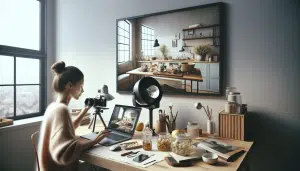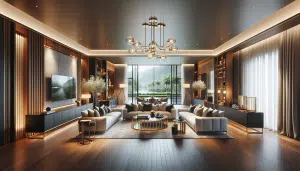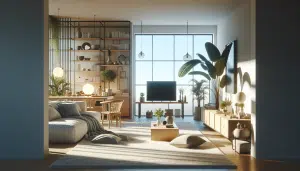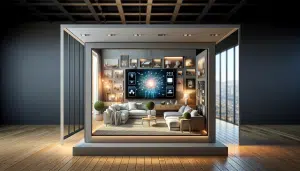Small Space Living Tricks You Haven’t Tried
Lily Carter September 26, 2025
Curious how small space living can actually boost comfort and style? Discover practical décor, storage, and organization hacks that make tiny apartments or studios functional and surprisingly inviting. This guide dives into the smart choices, creative ideas, and useful trends people use to transform their cozy homes.
Why Small Spaces Are Trending in Urban Living
Urban living has inspired a remarkable shift toward small space living. High rental prices and a quest for minimalism have encouraged many to rethink their priorities. Instead of giant apartments, compact homes now promise new possibilities for comfort, design, and sustainability. With less square footage comes opportunity for more intentional choices, which resonates with those who want a cozy space without clutter.
One benefit of small space living found in bustling cities is the focus on quality over quantity. Residents often invest in multi-functional pieces or thoughtful decorations that fit specifically into their lifestyle. Whether converting a windowsill into a reading nook or transforming a lofted bed area into extra storage, creativity comes alive within these constraints. There’s a sense of achievement in making every inch count.
For many small space dwellers, there’s also environmental motivation. These homes use fewer resources, require less energy for heating and cooling, and often draw attention to eco-friendly living. It’s remarkable how a compact lifestyle can merge sustainability with a desire for uplifting, individually styled homes. This trend isn’t just a reaction to cost; it’s about reshaping life for purpose and joy (Source: https://www.brookings.edu/articles/the-rise-of-urban-living/).
Transforming Storage and Organization in Compact Spaces
Making the most of limited square footage requires clever storage solutions. Vertical shelving is a prime example — walls become opportunities for floating bookshelves, hanging plants, or racks for kitchen essentials. Furniture choices can make all the difference, such as ottomans with hidden compartments or beds with built-in drawers. By using underutilized areas, like behind doors or beneath stairs, every nook is transformed into purposeful storage.
Organization in smaller spaces often means rotating items by season and prioritizing what’s genuinely needed. Decluttering routines can be more frequent and focused — think of it as an ongoing process instead of a once-a-year event. Labeling containers, installing baskets, and stackable organizers are just a few methods that add order without sacrificing style or function. It’s a balance of access and aesthetics that creates harmony in everyday routines.
Another innovative approach is modular furniture. Modular pieces, such as stackable cubes and expandable tables, are quickly adaptable to changing needs. Hosting guests or working from home? Rearranging these pieces transforms the same square footage again and again. Smart organization isn’t about having less, but about making what’s present work harder and look appealing while simultaneously reducing visual clutter (Source: https://nces.ed.gov/pubs93/web/93411.asp).
Styling Compact Homes for Comfort and Personality
Creating a home that feels both stylish and comfortable in a small setting might seem challenging, but it opens possibilities for inventive interior design. Light color palettes and mirrors are classic ways to make spaces feel brighter and more expansive. Strategically placed artwork, rugs, or greenery add personality while keeping visual harmony. Layering textures — think cozy throws and soft cushions — makes spaces inviting without causing clutter.
When styling a compact home, choosing décor that reflects personal taste while serving a function is key. Decorative baskets double as storage; folding screens offer privacy and act as art pieces. It’s possible to mix contemporary minimalism with bursts of color or vintage accessories to avoid monotony. Multifunctional design helps avoid crowding while maintaining a clear sense of identity within the space.
Lighting choices can also transform a compact home’s atmosphere. Flexible fixtures such as wall sconces or LED strips free up surface space and add ambiance. Plants placed on floating shelves or hanging from the ceiling bring life indoors without occupying precious floor area. Ultimately, comfort comes from personalizing the space, using every item intentionally, and embracing décor ideas that turn smallness into a feature (Source: https://www.huduser.gov/portal/pdredge/pdr-edge-featd-article-011117.html).
Living Well and Entertaining in Tiny Apartments
Hosting friends or relaxing alone in a small home is not only possible — it can be delightful. Thoughtful furniture arrangement makes room for flow and social activities. For example, a drop-leaf dining table can expand for guests, but shrink after meals. Folding chairs stored under a bed or sofa are convenient extras. Creating zones, even if visual, helps rooms do double duty without feeling cramped.
Preparation is an essential element for smooth entertaining in compact apartments. Serving finger foods or shared dishes cuts down on the need for large serving pieces and plateware. Multi-level trays or portable carts add space and mobility, making it easier to adapt as needed. Sound systems or compact projectors deliver a full experience for movie or game nights without taking over the room. Details matter more when space is at a premium.
Embracing a minimalist mindset helps ensure there’s always room for joy. Focus on warm lighting, conversation-friendly layouts, and flexible seating. Inviting friends can feel cozy, not crowded, when every element is there for a reason. As people share experiences in thoughtfully arranged spaces, intimacy and ease become part of the entertainment, often prompting guests to want to try these strategies themselves (Source: https://www.nationalgeographic.org/article/designing-your-tiny-house/).
The Role of Technology in Small Space Solutions
Technology is a powerful ally in small space living. Smart home devices, such as compact air purifiers, Bluetooth speakers, or lighting controlled via mobile apps, eliminate unnecessary clutter from surfaces and shelves. Devices today are sleeker and more versatile, fitting effortlessly into multi-use environments. The rise of wireless charging stations and foldable screens makes tech setup both invisible and functional.
Innovations also support remote work and entertainment from home. Ultra-thin laptops and all-in-one monitors can instantly transform a living room into a productive workspace. Virtual assistant speakers save space on lists and calendars, giving audible reminders and hands-free control. Modular smart plugs and sensors help manage energy use, aligning with eco-friendly goals that often accompany compact living.
Additionally, automated cleaning robots and sophisticated air filtration units fit seamlessly into daily life, minimizing housework and maximizing comfort. Streamlined appliances — think combination microwave ovens or washer-dryer units — handle everyday chores efficiently without crowding. All these advances let even the smallest homes function with the sophistication of much larger spaces, blending tech with organization (Source: https://www.cnet.com/home/smart-home/how-to-make-the-most-of-a-small-living-space/).
Maximizing Mental Wellbeing in Small Environments
A mindful approach to small space living can greatly impact mental wellbeing. Choosing calming colors, letting in natural light, and prioritizing fresh air are just the beginning. Regularly refreshing what’s on display and removing excess can create a sense of control and ease. In tight quarters, every object in sight sets the mood, so curating these elements pays off.
Routine maintenance and organized daily habits create predictability and order, reducing stress. Having a dedicated spot for work, rest, and play is possible even in one room, thanks to clever room dividers or reversible furniture. Introducing rituals, like morning coffee by the window or an evening wind-down with soft lighting, brings growthful structure to apartment life.
Finally, connecting with outdoor spaces — rooftops, community gardens, or local parks — prevents the feeling of being boxed in. Socializing virtually, pursuing hobbies, or simply sitting quietly gives small space dwellers a sense of community and purpose. Wellbeing flourishes when the space, however compact, is shaped to support individual rhythms and happiness (Source: https://www.apa.org/topics/interior-design-mental-health).
References
1. Brookings Institution. (n.d.). The Rise of Urban Living. Retrieved from https://www.brookings.edu/articles/the-rise-of-urban-living/
2. National Center for Education Statistics. (n.d.). Organization and Storage in Small Spaces. Retrieved from https://nces.ed.gov/pubs93/web/93411.asp
3. HUD User. (n.d.). Small Efficient Homes. Retrieved from https://www.huduser.gov/portal/pdredge/pdr-edge-featd-article-011117.html
4. National Geographic Society. (n.d.). Designing Your Tiny House. Retrieved from https://www.nationalgeographic.org/article/designing-your-tiny-house/
5. CNET. (n.d.). How to Make the Most of a Small Living Space. Retrieved from https://www.cnet.com/home/smart-home/how-to-make-the-most-of-a-small-living-space/
6. American Psychological Association. (n.d.). The Impact of Interior Design on Mental Health. Retrieved from https://www.apa.org/topics/interior-design-mental-health







